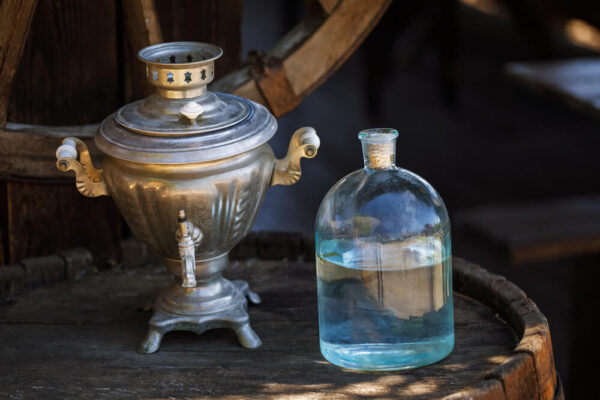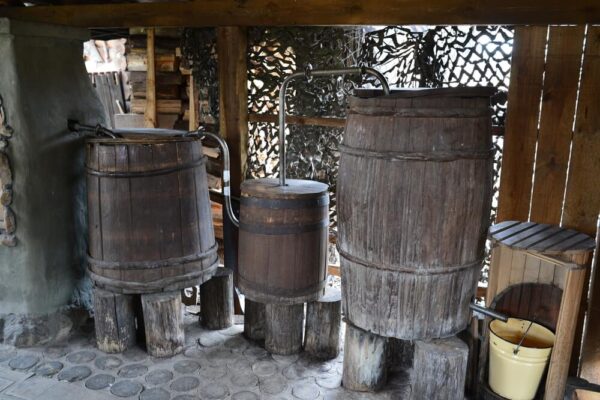Measuring your moonshine’s proof is one of the most exciting parts of the distillation process. It is when you finally get to discover how strong your moonshine really is.
If you manage to reach your target proof, you’ll earn some bragging rights and be able to tell your friends about the strength of your hooch. If you don’t quite make it, you’ll have to head back to the drawing board.
In this guide, I’ll share everything you need to know about proofing moonshine. I’ll explain what proof is, and share two techniques for proofing before answering a few commonly asked questions.

What Is Proof?
Alcohol proof is a measurement which tells you how much alcohol is in a liquid. The term was first used in 16th century England, when alcoholic drinks were taxed based on the amount of alcohol they contained.
The tax collectors would attempt to light the spirit they were testing on fire. If they succeeded, it was considered ‘above proof’ and taxed as liquor. If it resisted fire, it was ‘under proof’.
The ‘gunpowder test’ was also used. If gunpowder soaked in the solution could still combust, it was over proof or ‘100 proof’. As you might have guessed, both tests were fairly inaccurate.
These techniques for measuring proof were abandoned in the 17th century, when the government started using tests based on specific gravity. This test uses the density of a liquid compared to the density of water to determine alcohol content.
100 proof was defined as a “spirit with 12⁄13 the specific gravity of pure water at the same temperature”. This is the same as 57.15% ABV, which is a reasonably strong bottle of spirits.
The United States developed their own system for proofing alcohol in the 1840s. It used the percentage of alcohol in a spirit to determine proof, with 50% alcohol by volume being considered 100 proof.
Related: What is a Thumper Keg?
ABV vs. Proof
Most spirits sold in shops today will use alcohol by volume (ABV) instead of proof. In the United States alcohol proof is twice the percentage of alcohol by volume. This means your average bottle of 40% ABV moonshine will be 80 proof.
2 Methods for Proofing Moonshine

1. Using The Shake Test Method For Proofing Moonshine
The original moonshiners didn’t have access to hydrometers so had to rely on their experience and knowledge to determine how strong each batch of moonshine was.
They would come up with an accurate estimation of a spirit’s proof based on the several factors including the brew time of the wort, the operation of the still, and the quality of ingredients being used. Skilled distillers would also use the ‘shake test’ to determine proof.
Bubbles in Moonshine
The shake test involves placing some moonshine in a mason jar and giving it a vigorous shake. If the spirit has large bubbles that disappear quickly, it would indicate that the batch is higher proof. If the spirit has small bubbles which disappear slowly, it would indicate a lower proof.
This test works because alcohol molecules are larger and less dense than water molecules. In other words, the atoms in an alcohol molecule are further apart than they are in water molecules.
So, when you shake a bottle of water, the air bubble escape quickly, as there is no place for them to sit between the tightly packed water molecules. They float to the top of the bottle very quickly.
However, let’s say you are shaking a bottle of 100 proof moonshine (50% water 50% alcohol). When you shake it, the air bubbles will begin to compete with the water molecules to fill the empty space around the alcohol molecules. This makes the air bubbles disappear slowly.
If you have a high proof alcohol of 150 proof, you would have about 25% water and 75% alcohol. When you shake the bottle, the air bubbles don’t have to compete with the water as much, because there are plenty of alcohol molecules to cluster around. This means the bubbles will disappear quickly.
Although the bubbles test sounds somewhat inaccurate, experienced moonshiners are incredibly accurate at determining proof using this technique. They often use mason jars full of moonshine from past batches to compare moonshine proof using the shake test.
Related: Interesting Facts About Moonshine
2. How To Proof Moonshine Using A Hydrometer
A hydrometer is a sealed glass instrument which is used to measure the proof or ABV of a spirit. It works by measuring the density of your spirit compared to the density of water.
There are two types of hydrometers used by distillers: a proofing hydrometer and a brewing hydrometer. The main difference between the two is the scale they use.
The brewing hydrometer is designed to test the alcohol content or potential alcohol content of a moonshine mash. It can take measurements up to about 20% ABV.
The proofing hydrometer, also called an alcoholmeter, is used to measure the final alcohol content of your distilled moonshine. It can usually take measurements up to 200 proof (100% ABV).
To take a measurement, you simply float the hydrometer in your moonshine and look at the ABV/proof reading on the side.
However, the best way to use a hydrometer when making moonshine is to use a copper moonshine parrot. The parrot is a vessel that is placed between the still and a collection vessel. It has an inlet which receives distillate from the still, a chamber to hold a hydrometer, and an outlet to send distillate to a collection jar.
The distillate will fill up the parrot, causing the hydrometer to float. You can then get a quick reading of your moonshine’s proof as it comes out of the still. Once the parrot is full, the distillate begins to flow into the collection vessel.
Being able to see the proof of the spirit as it is being produced can help you make cuts during the run. It also helps you keep track of the proof being produced throughout the run.
- High Quality Proof & Tralle Test KitT: American made, N.I.S.T. Traceable 0-200 Proof & Tralles Hydrometer for alcohol (Made in the USA) meeting or exceeding the standards set by the National Institute of Standards and Technology. 0-200 PROOF scale for alcohol proofer testing spirits, high alcohol liquor, moonshine, corn whiskey, barrel aging dissipation, infusion batch and tincture recipes or other high alcohol content home distilling beverages for alcohol content measuring.
- Hydrometer for Moonshine Testing: Distillers, buy the best homebrew hydrometer alcohol proofer - Float your new Brewing America proofing hydrometer for moonshine for your alcohol testing in your still parrot or draw your sample to gauge your grain liquor proof measurement to measure alcohol content in your new Brewing America borosilicate glass test cylinder, either way, you have what you need!
- Everything You Need: What's included: One Made In America Brewing America Alcoholmeter (also called a Proof and Tralle Hydrometer for homebrew or spiritometer), One solid borosilicate Glass Test Tube Jar Cylinder, One sturdy Bottle Brush made of Stainless Steel designed specifically for our very narrow test jar, One plastic storage tube, One foam filled, sturdy outer box. We also include one microfiber cloth and our 2- page direction sheet with a conversion chart.
Related: Moonshine Distilleries
What Is The Highest Proof Moonshine
The highest proof moonshine you can make using distillation will be 191 proof (95.5% ABV). That’s because alcohol begins to attract moisture from the air at concentrations higher than 96% ABV, immediately diluting your moonshine.
It’s worth noting that in most parts of the United States, it is illegal to distill moonshine above 160 proof (80% ABV) and it cannot be bottled at more than 125 proof (62.5% ABV).
Related: Appalachia Moonshine History
Is 200 Proof Moonshine Possible?
It’s not possible to make 200 proof moonshine using distillation alone. However, there are several ways to produce alcohol this pure including the use of a molecular sieve, which removes the last 5% of water from 191 proof moonshine. Pure ethanol is usually made from dehydrated 191 proof spirits.
Moonshine Proof Range
There are no hard and fast rules for how high the proof of moonshine should be. During the Prohibition era, bootleggers made moonshine ranging from 63 proof through to 190 proof. However, most commercial moonshines are between 60 to 120 proof (30% to 60% ABV). Flavored moonshine is usually even lower at 50 to 70 proof (25% to 35% ABV).
What Proof Is Moonshine Usually?
If you walk into your local liquor store and grab the first bottle of moonshine you see, it will probably be 80 proof (40% ABV).
